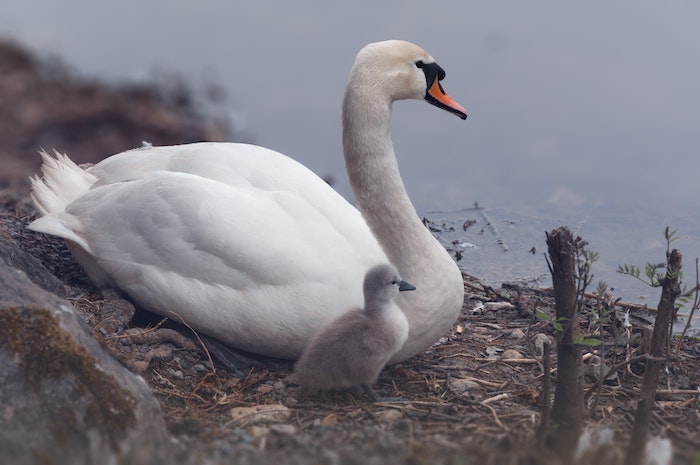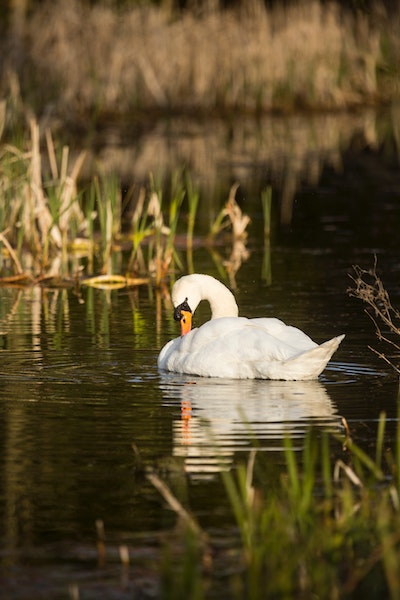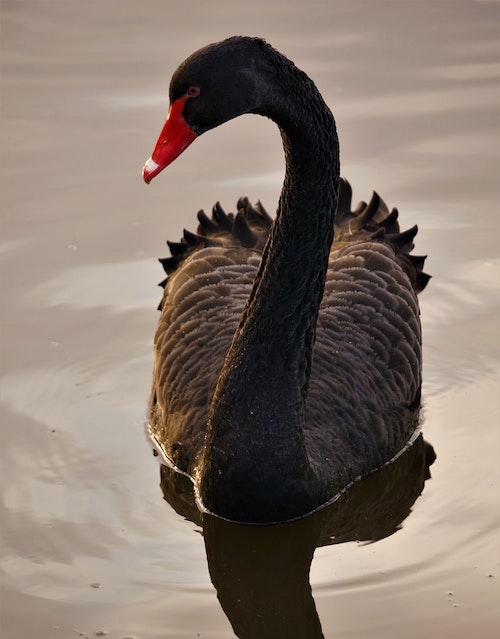Swans and Paddle Boarding
Paddle boarding has become increasingly popular over the last few years, and for good reasons. After all, it’s an excellent way to exercise and enjoy the incredible beauty of nature during the weekends.

But, this exciting watersport can become annoying or even downright terrifying when you’re on the water with aggressive swans!
For instance, while these waterfowls have a majestic appearance, if you somehow end up in their territory, they will often try to nip at your feet or kick out at you with their mighty wings if they feel threatened by your presence.
However, there are several ways to prevent such swan attacks when paddle boarding. Also, there are protective measures that can reduce the risk of injury for the paddler.
So, in this post, we’ll take a look at swan behavior, the types you’ll need to keep an eye out for, and the measures to deal with swans while paddleboarding.
Why would swans be aggressive?
Swans are beautiful creatures that you can commonly find in many rivers, lakes, and ponds. Moreover, they don’t typically bother humans unless they feel like you’re invading their territories or threatening their young ones.
Still, there are exceptions since most swans are aggressive towards other swans, birds to secure food and nesting areas.
Therefore, these waterfowl develop a highly territorial behavior. Thus, paddling anywhere inside this area can cause the swans, especially the males or cobs, to chase after the intruder. Nevertheless, this aggression is less intense during July or August when the birds go through the molting.
Also, there’s more to the swan’s aggressive nature than what meets the eye at first glance. So, let’s take a more detailed look at the specific times when they might be aggressive.
1. Swan nesting areas and territories
Swans tend to nest in shallow, uncontaminated waters. They also search for areas that have abundant food sources.
Usually, these nesting territories range from 6 to 150 acres for one pair of the waterfowls.
Here, the pair will compete for food with any other birds or even other swans. Thus, paddleboarding near such a nesting area will mark the rider as a potential competitor for food.
2. Egg-laying season
Typically, during late April-June, the female swan starts to lay eggs. In this season, the cobs, male swans will hunt for food aggressively since the females will rarely leave the nest.
Moreover, even after 35-41 days of incubation, the swans will remain highly aggressive to ward off any threats towards the young ones.
3. Protecting their cygnets
Swans will be very protective of their young and this is the time when they are very likely to attack. You can recognise a swan with their cygnets when they are white swans as the young will be grey colour.

Aggressiveness and Types of Swan
Not all swans are equally aggressive. Depending on their habitat, diet, you can often avoid a swan attack altogether if you know about their types.
So, let’s go over some of the most common swan types and their differences,
1. Mute swans

Mute swans are one of the most aggressive waterfowls you may encounter while SUPing. They usually nest on large mounds, shallow water vegetations.
Moreover, they aggressively defend their territory, mate, and offspring. But, fortunately, their mighty wings beat and let out a loud sound before charging at the intruder. This sound would let you prepare for an impending swan attack.
2. Black Swans
A bit more uncommon than their white cousins, the black swans are native to Australia. They are also pretty aggressive. This aggression is even more intense towards humans to the point that they can be more dangerous than the mute swans!
In contrast, their black plumage and bright red beaks make them visible from a long distance. This way, as long as you’re careful, you’ll be able to avoid them without too much hassle.

3. Trumpeter Swans
The trumpeter swans are probably the best waterbirds you can encounter on the Northwestern US water. After all, while these birds are massive, they are far less aggressive than the previous two species.
Additionally, you can recognize them through their black, tapered bill. Furthermore, if you encounter them in a popular paddleboarding area, chances are, they will adapt to your presence pretty quickly.
Ways to Deal with a Swan Attack
There are several ways to effectively deal with a swan attack while paddling a SUP board. So, in this section, we’ll go over the preventive and protective measures you can take to avoid the swans or minimize the damages in case of an emergency.
Thus, without further ado, let’s take a look,
1. Preventive measure
It’s better to prevent a swan attack rather than to face the birds on the water. After all, they can be surprisingly fast despite having a large body, and their beaks and wings are powerful enough to injure an unaware paddleboarder seriously.
As such, here are a few ways to avoid them altogether,
- Keep an eye out for swan nesting areas like shallow waters, vegetation, and high mounds.
- If you manage to spot such an area and avoid it, there’s a high chance that you won’t have to deal with the territorial swans.
- Moreover, during the egg-laying seasons, these waterfowls can be more aggressive. As such, you may want to avoid paddling in shallow areas during April-June.
- When swans have young with them, give them a wide birth, as you will be viewed as a threat.
Aside from these, you can use decoys to attract the swans in a specific area and keep them away from your watercraft. Also, you can put camouflage on your SUP board to make it harder to spot from a long distance.

2. Protective measures
In case the preventive measures fail, then you’ll need to protect yourself from the aggressive birds.
So, here’s a few ways to protect yourself effectively,
- As a first step, if you need to get past them, try to do so as far away as possible, and paddle slowly past. If you are somewhere where people regularly paddle board, the swans may well be used to it, and many will not be aggressive anyway.
- You will want to avoid hitting swans, especially as this may be illegal! However, is worse comes to worse, usually, the SUP paddles are excellent for keeping the swans away. Plus, you can rotate it in a circular motion around you to scare the birds away or even knock then out the way them if really necessary!
- However, this method is only effective if you’re on a stable paddleboard. But, you can kneel on the deck pad and swing the paddle for extra stability. Still, this will leave you more open to the swan’s attack if you fail to whack the waterfowls.
- Also, you can keep a lightweight water pistol on you if you plan to paddle in swan nesting areas.
- Typically, spraying an arc of water near the swans from a distance will keep them away from you.
- Another way to protect yourself from the swans is to swing a storage rope in a circle around your watercraft.
- Nevertheless, you should avoid using ropes connected to a SUP anchor, as this can seriously injure you or even capsize your board.
- Last but not least, wear a life jacket. The heavy-duty vests, jackets are often sturdy enough to soften the blow from the swans.
There are other ways to protect yourself from swan attacks, like using the emergency whistle to scare them away. But, this method may not work on all types of swan species.
Moreover, you can charge towards some swans to disperse them and paddle far enough away if you’re on a fast paddleboard.
A Few Tips to Stay Safe
The water, weather can be pretty unpredictable, and the swans add to the danger. As such, you’ll need to be fully prepared to deal with emergencies if you wish to enjoy a smooth paddleboarding experience.
With that in mind, here are a few tips and tricks to stay safe on the water while paddling,
- Before heading out, wear a SUP safety leash and a PFD. This way, even if you’re startled and hit the water during a swan attack, you’ll be able to get back on the board with minimal hassle.
- Also, you can try to locate a local paddleboarder or an experienced guide to find out more about the swan population in the area.
- Furthermore, learning about the local swan species and their behavior will help you identify them faster and avoid them if necessary.
Besides these, you may want to bring enough supplies to keep hydrated and battle exhaustion. After all, an dehydrated, exhausted body won’t be of much help if you run into aggressive swans.
Bottom Line
Whether you wish to enjoy a relaxing weekend with your family or explore the waterways on your favorite SUP board, knowing how to deal with swans is sure to improve your safety.
After all, even a single pair of angry swans can quickly ruin the day for you if you’re not careful!
Thus, you may want to prepare safety measures and learn about these aggressive water birds before planning your extended paddleboarding trips. Afterward, these measures will not only keep you and your friends safe, but they’ll also give you a boost of confidence.
So, prepare your preventive and protective measures for swan attacks and safely enjoy your next paddleboarding adventure!
Leave a Reply